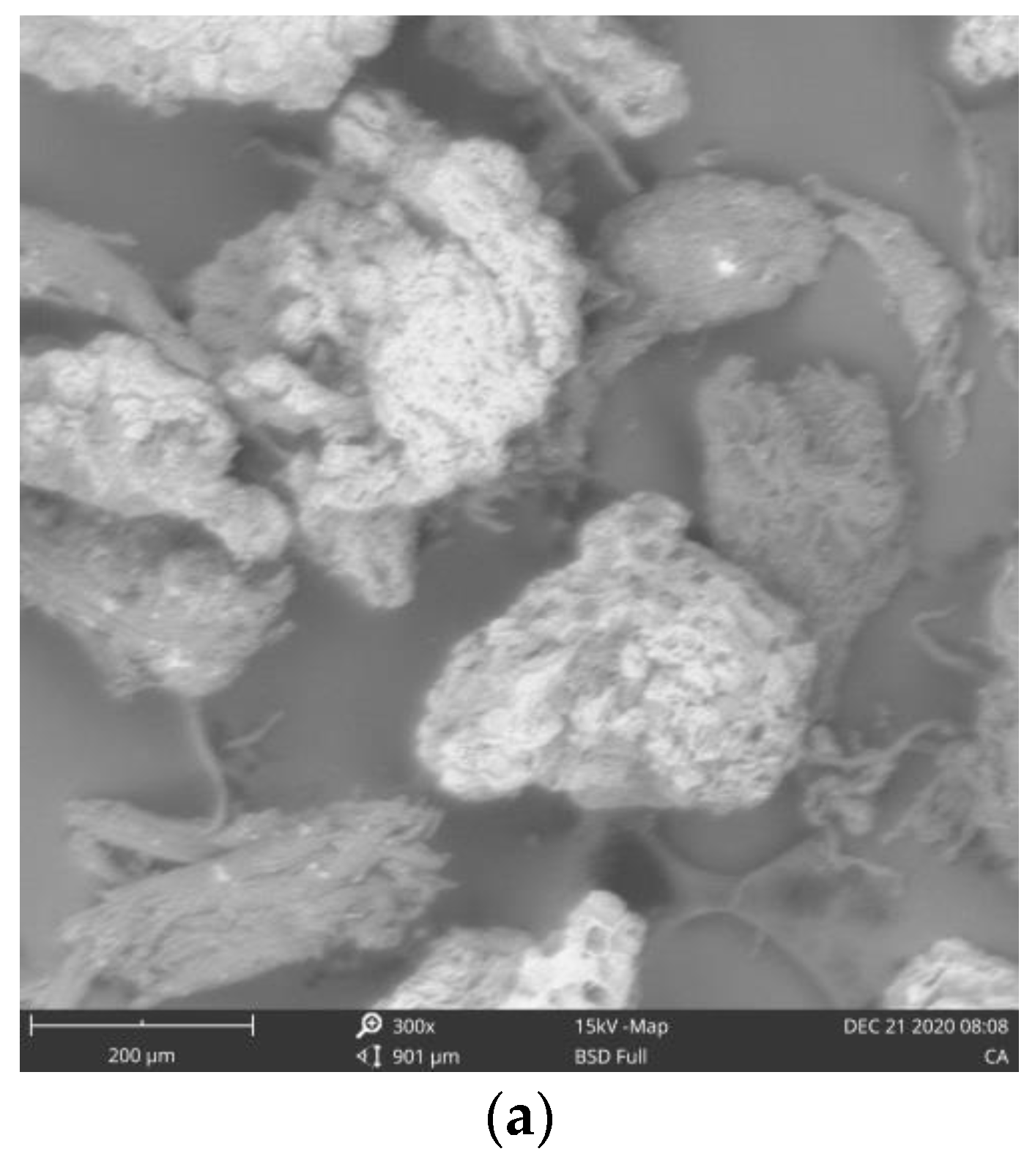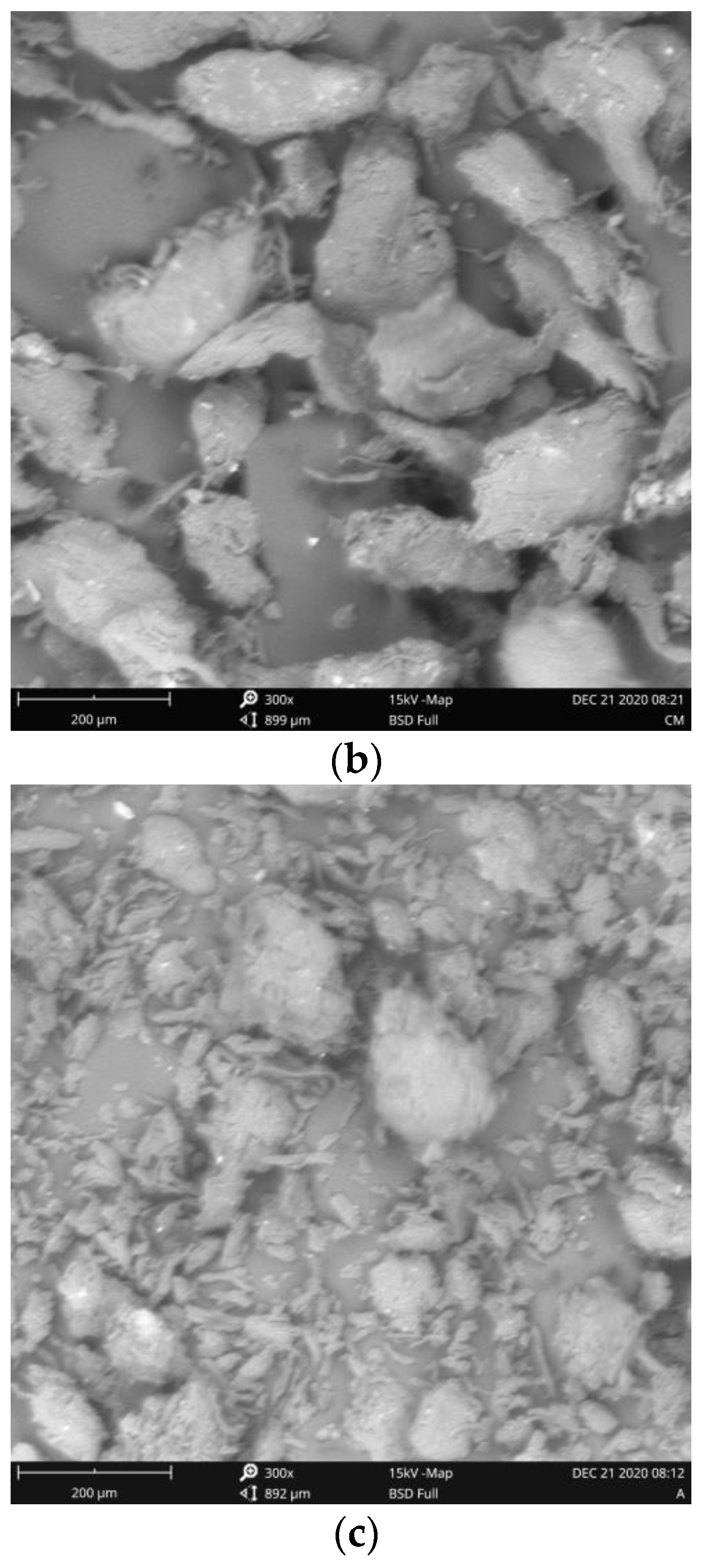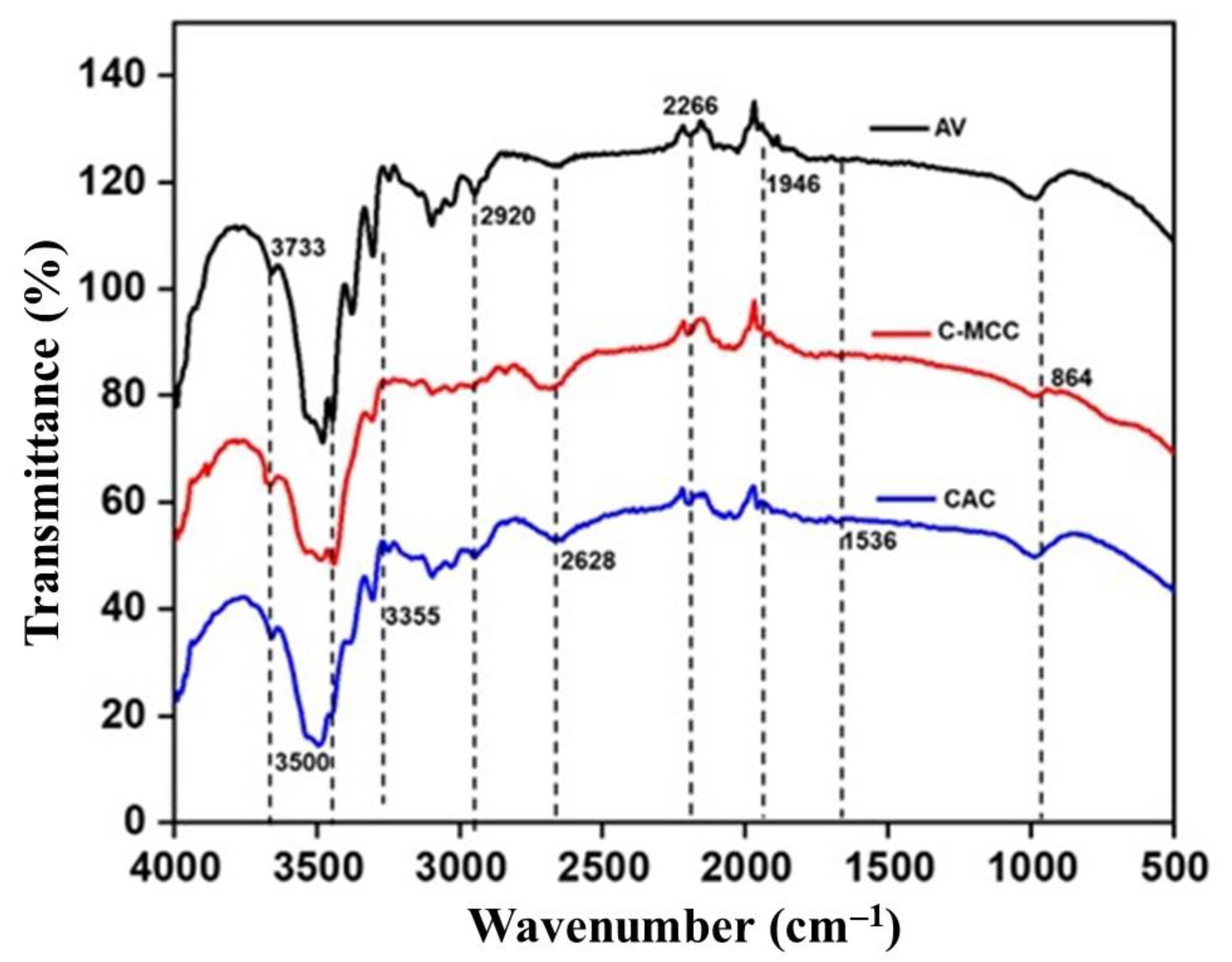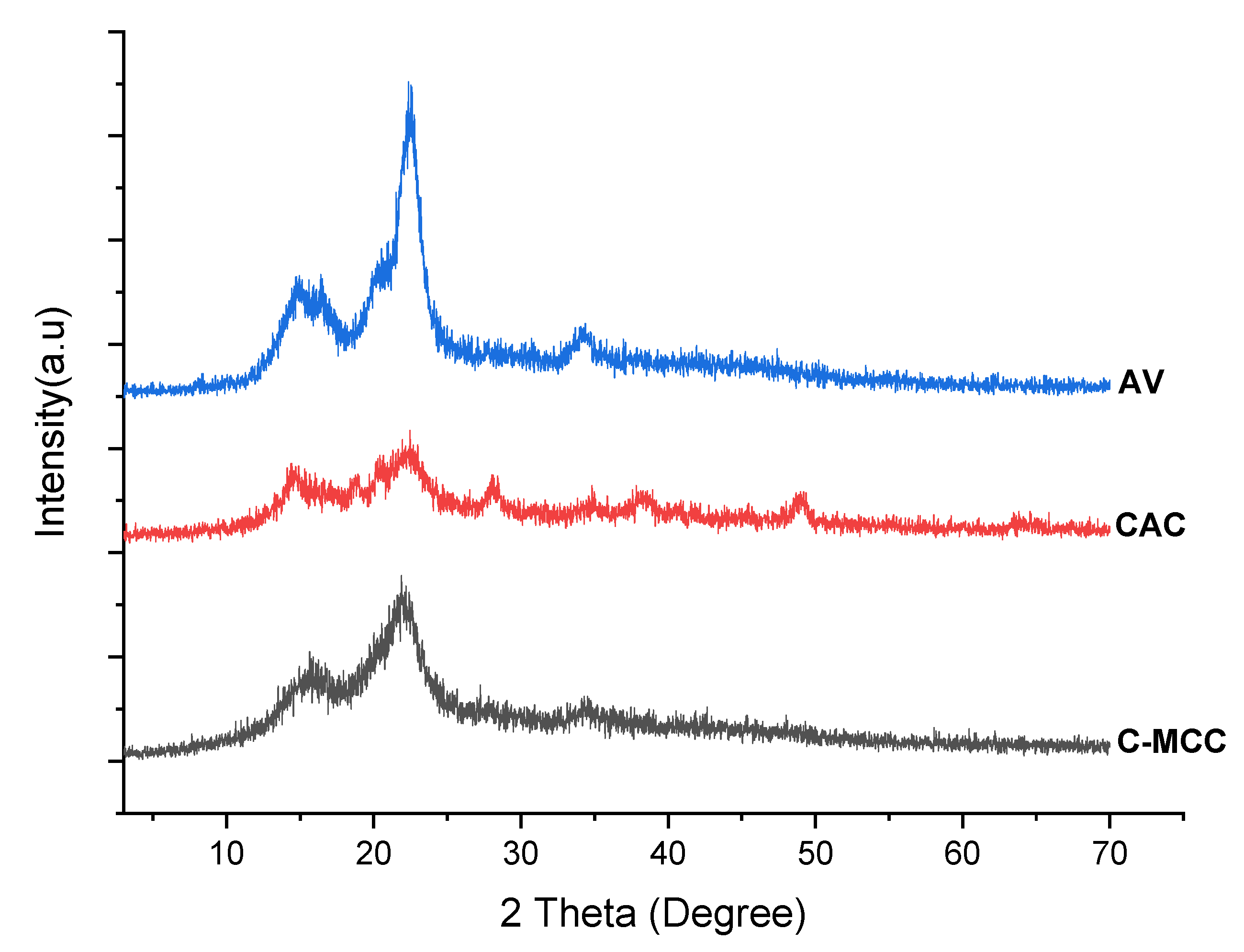Characterizations of Alpha-Cellulose and Microcrystalline Cellulose Isolated from Cocoa Pod Husk as a Potential Pharmaceutical Excipient
Abstract
:1. Introduction
2. Materials and Methods
2.1. Reagents
2.2. Collection and Preparation of Cocoa Pod Husk (CPH)
2.3. Phytochemical Screening of Cocoa Pod Husk (CPH)
2.4. Extraction of Cocoa Alpha-Cellulose (CAC) from Cocoa Pod Husk (CPH)
2.5. Isolation of Cocoa Microcrystalline Cellulose (C-MCC) from Cocoa Pod Husk (CPH)
2.6. General Cellulose Identification Tests
2.6.1. Solubility Test
2.6.2. Chemical Tests
2.6.3. Degree of Polymerization Determination
2.6.4. Phytochemical Screening of Cocoa Alpha-Cellulose (CAC) and Cocoa Microcrystalline Cellulose (C-MCC)
2.7. Physicochemical Properties of the Cellulose Types
2.7.1. pH Determination
2.7.2. Bulk and Tapped Density
2.7.3. True Density
2.7.4. Angle of Repose
2.7.5. Hausner Ratio Assesses the Inter-Particle Friction in a Powder Bed Giving an Insight into Powder Flow Properties
2.7.6. Carr’s Index
2.7.7. Powder Porosity
2.7.8. Particle Size Distribution (PSD) Measurement
2.7.9. Swelling Capacity
2.7.10. Moisture Content
2.8. Physical Characterizations of the Cellulose Types
2.8.1. Scanning Electron Microscopy (SEM)
2.8.2. Fourier-Transform Infrared (FTIR) Spectroscopy
2.8.3. X-ray Diffraction (XRD)
2.8.4. Differential Scanning Calorimetry (DSC) Analysis
2.9. Tablet Formulation and Compression
2.10. Tablet Evaluation
2.10.1. Determination of Tablet Hardness
2.10.2. Determination of Tablet Friability
2.10.3. Determination of Disintegration Time of Tablets
2.10.4. Statistical Analysis
3. Results and Discussion
3.1. Yield of the Cellulose Types
3.2. Identification Parameters of the Cellulose Types
3.3. Phytochemical Screening of Cocoa Pod Husk (CPH), Cocoa Alpha-Cellulose (CAC), Cocoa Microcrystalline Cellulose (C-MCC)
3.4. Physicochemical Properties of the Cellulose Types
3.4.1. Organoleptic Properties of the Cellulose Types
3.4.2. Particle Size of the Cellulose Types
3.4.3. Density Measurements of the Cellulose Types
3.4.4. Moisture Content of the Cellulose Types
3.4.5. Swelling Properties of the Cellulose Types
3.4.6. Flow Properties of the Cellulose Types
3.5. Physical Characterization of the Cellulose Types
3.5.1. Scanning Electron Microscopy (SEM)
3.5.2. Fourier-Transform Infrared Spectroscopy (FTIR)
3.5.3. X-ray Diffraction (XRD)
3.5.4. Differential Scanning Calorimetry (DSC)
3.5.5. Evaluation of Tablets
4. Conclusions
Author Contributions
Funding
Institutional Review Board Statement
Informed Consent Statement
Data Availability Statement
Conflicts of Interest
References
- Adel, A.M.; El-shinnawy, N.A. Hypolipidemic applications of microcrystalline cellulose composite synthesized from different agricultural residues. Int. J. Biol. Macromol. 2012, 51, 1091–1102. [Google Scholar] [CrossRef] [PubMed]
- Zhu, H.; Luo, W.; Ciesielski, P.N.; Fang, Z.; Zhu, J.Y.; Henriksson, G.; Himmel, M.E.; Hu, L. Wood derived materials for green electronics, biological devices, and energy applications. Chem. Rev. 2016, 116, 9305–9374. [Google Scholar] [CrossRef] [PubMed]
- Du, H.; Liu, W.; Zhang, M.; Si, C.; Zhang, X.; Li, B. Cellulose nanocrystals and cellulose nanofibrils based hydrogels for biomedical applications. Carbohydr. Polym. 2019, 209, 130–144. [Google Scholar] [CrossRef]
- French, A.D. Glucose, not cellobiose, is the repeating unit of cellulose and why that is important. Cellulose 2017, 24, 4605–4609. [Google Scholar] [CrossRef]
- Zhao, T.; Chen, Z.; Lin, X.; Ren, Z.; Li, B.; Zhang, Y. Preparation and characterization of microcrystalline cellulose (MCC) from tea waste. Carbohydr. Polym. 2018, 184, 164–170. [Google Scholar] [CrossRef] [PubMed]
- Klemm, D.; Heublein, B.; Fink, H.P.; Bohn, A. Cellulose: Fascinating biopolymer and sustainable raw material. Angew. Chem. Int. Ed. 2005, 44, 3358–3393. [Google Scholar] [CrossRef]
- Shokri, J.; Adibkia, K. Application of cellulose and cellulose derivatives in pharmaceutical industries. In Cellulose—Medical, Pharmaceutical and Electronic Applications; Ven, T.V., Godbout, L., Eds.; IntechOpen: London, UK, 2013. [Google Scholar] [CrossRef]
- Ullah, H.; Santos, H.A.; Khan, T. Applications of bacterial cellulose in food, cosmetics and drug delivery. Cellulose 2016, 23, 2291–2314. [Google Scholar] [CrossRef]
- Osorno, D.M.; Castro, C. Cellulose application in food industry: A review. In Emergent Research on Polymeric and Composite Materials; Somashekar, R., Thejas, G., Eds.; IgI Global Publisher: Hershey, PA, USA, 2018; pp. 38–77. [Google Scholar] [CrossRef]
- Bianchet, R.T.; Cubas, A.V.; Machado, M.M.; Moecke, E.S. Applicability of bacterial cellulose in cosmetics—Bibliometric review. Biotechnol. Rep. 2020, 27, e00502. [Google Scholar] [CrossRef]
- Trache, D.; Thakur, V.K.; Boukherroub, R. Cellulose nanocrystals/graphene hybrids—A promising new class of materials for advanced applications. Nanomaterials 2020, 10, 1523. [Google Scholar] [CrossRef]
- Mittal, A.; Katahira, R.; Himmel, M.E.; Johnson, D.K. Effects of alkaline or liquid-ammonia treatment on crystalline cellulose: Changes in crystalline structure and effects on enzymatic digestibility. Biotechnol. Biofuels 2011, 4, 41. [Google Scholar] [CrossRef] [PubMed]
- Sullivan, A.O. Cellulose: The structure slowly unravels. Cellulose 1997, 4, 173–207. [Google Scholar] [CrossRef]
- Kambli, N.D.; Mageshwaran, V.; Patil, P.G.; Saxena, S.; Deshmukh, R.R. Synthesis and characterization of microcrystalline cellulose powder from corn husk fibres using bio-chemical route. Cellulose 2017, 24, 5355–5369. [Google Scholar] [CrossRef]
- Szymańska-Chargot, M.; Chylińska, M.; Gdula, K.; Kozioł, A.; Zdunek, A. Isolation and characterization of cellulose from different fruit and vegetable pomaces. Polymers 2017, 9, 495. [Google Scholar] [CrossRef] [PubMed]
- Rivai, H.; Hamdani, A.S.; Ramdani, R.; Lalfari, R.S.; Andayani, R.; Armin, F.; Djamaan, A. Production and characterization of alpha cellulose derived from rice straw (Oryza sativa L.). Int. J. Pharm. Sci. Rev. Res. 2018, 52, 45–48. [Google Scholar]
- Nsor-Atindana, J.; Chen, M.; Goff, H.D.; Zhong, F.; Sharif, H.R.; Li, Y. Functionality and nutritional aspects of microcrystalline cellulose in food. Carbohydr. Polym. 2017, 15, 159–174. [Google Scholar] [CrossRef]
- Thoorens, G.; Krier, F.B.; Evrard, C.B. Microcrystalline cellulose, a direct compression binder in a quality by design environment—A review. Int. J. Pharm. 2014, 473, 64–72. [Google Scholar] [CrossRef] [PubMed]
- Adedokun, M.; Essien, G.E.; Uwah, T.; Romanus, A.U.; Josiah, I.; Jackson, C. Evaluation of the release properties of microcrystalline cellulose derived from Saccharum officinarum L. in paracetamol tablet formulation. J. Pharm. Sci. Res. 2014, 6, 342–346. [Google Scholar]
- Belali, N.G.; Chaerunisaa, A.Y.; Rusdiana, T. Isolation and characterization of microcrystalline cellulose derived from plants as excipient in tablet: A review. Indonesian J. Pharm. 2019, 1, 23–29. [Google Scholar] [CrossRef]
- Campos-Vega, R.; Nieto-Figueroa, K.H.; Oomah, B.D. Cocoa (Theobroma cacao L.) pod husk: Renewable source of bioactive compounds. Trends Food Sci. Technol. 2018, 81, 172–184. [Google Scholar] [CrossRef]
- Lu, F.; Rodriguez-Garcia, J.; Damme, I.V.; Westwood, N.J.; Shaw, L.; Robinson, J.; Warren, G.; Chatzifragkou, A.; Mason, S.M.; Gomez, L.; et al. Valorisation strategies for cocoa pod husk and its fractions. Curr. Opin. Green Sustain. Chem. 2018, 14, 80–88. [Google Scholar] [CrossRef]
- Lubis, M.; Gana, A.; Maysarah, S.; Ginting, M.H.; Harahap, M.P. Production of bioplastic from jackfruit seed starch (Artocarpus heterophyllus) reinforced with microcrystalline cellulose from cocoa pod husk (Theobroma cacao L.) using glycerol as plasticizer. IOP Conf. Ser. Mater. Sci. Eng. 2018, 309, 012100. [Google Scholar] [CrossRef]
- Dahunsi, S.O.; Adesulu-Dahunsi, A.T.; Izebere, J. Cleaner energy through liquefaction of cocoa (Theobroma cacao) pod husk: Pretreatment and process optimization. J. Clean Prod. 2019, 226, 578–588. [Google Scholar] [CrossRef]
- Kilam, G.; Lating, P.O.; Byaruhanga, J.; Biira, S. Quantification and characterization of cocoa pod husks for electricity generation in Uganda. Energy Sustain. Soc. 2019, 9, 22. [Google Scholar] [CrossRef]
- Jimat, D.N.; Jami, M.S. Extraction of microcrystalline cellulose (MCC) from cocoa pod husk via alkaline pretreatment combined with ultrasonication. Int. J. Appl. Eng. Res. 2016, 11, 9876–9879. [Google Scholar]
- Akinjokun, A.I.; Petrik, L.F.; Ogunfowokan, A.O.; Ajao, J.; Ojumu, T.V. Isolation and characterization of nanocrystalline cellulose from cocoa pod husk (CPH) biomass wastes. Heliyon 2017, 7, e06680. [Google Scholar] [CrossRef] [PubMed]
- Hossain, M.A.; AL-Raqmi, K.A.; AL-Mijizy, Z.H.; Weli, A.M.; Al-Riyami, Q. Study of total phenol, flavonoids contents and phytochemical screening of various leaves crude extracts of locally grown Thymus vulgaris. Asian Pac. J. Trop. Biomed. 2013, 3, 705–710. [Google Scholar] [CrossRef]
- Seow, L.J.; Behm, H.K.; Sadikun, A.; Asmawi, M.Z. Preliminary phytochemical and physicochemical characterization of Gynura segetum (Lour) Merr (Compositae) leaf. Trop. J. Pharm. Res. 2013, 12, 777–782. [Google Scholar] [CrossRef]
- Ohwoavworhua, F.O.; Adelakun, T.A. Some physical characteristics of microcrystalline cellulose obtained from raw cotton of Ochlospermum planchonii. Trop. J. Pharm. Res. 2005, 4, 501–507. [Google Scholar] [CrossRef]
- Ejikeme, P.M. Investigation of the physicochemical properties of microcrystalline cellulose from agriculture Wastes I: Orange Mesocarp. Cellulose 2008, 15, 141–147. [Google Scholar] [CrossRef]
- Guy, A.; Podczeck, F. Handbook of Pharmaceutical Excipients; Pharmaceutical Press: London, UK, 2017. [Google Scholar]
- Young, F.S.; Hindson, W.R. 40—the identification of damage to lignified fibres a new microscopical test using iodine and sulphuric acid. J. Text. Inst. 1958, 49, T554–T556. [Google Scholar] [CrossRef]
- U.S. Pharmacopoeia. Microcrystalline cellulose. In National Formulary [USP 39 NF 24]; Rockville, M.D., Ed.; United States Pharmacopeial Convention, Inc.: Rockville, MD, USA, 2015; Volume 4, p. 7231. [Google Scholar]
- Karande, V.S.; Bharimalla, A.; Hadge, G.B.; Mhaske, S.T.; Vigneshwaran, N. Nanofibrillation of cotton fibers by disc refiner and its characterization. Fibers Polym. 2011, 12, 399. [Google Scholar] [CrossRef]
- Adeleye, O.A.; Femi-Oyewo, M.N.; Odeniyi, M.A.; Ajala, T.O. Evaluation of Cissus populnea gum as a directly compressible matrix system for tramadol hydrochloride extended-release tablet. J. Appl. Pharm. Sci. 2019, 9, 105–111. [Google Scholar] [CrossRef]
- Adeleye, O.A.; Odeniyi, M.A.; Femi-Oyewo, M.N. Physicochemical and rheological characterization of Cissus populnea gum extracted by different solvents. West Afr. J. Pharm. 2015, 26, 113–126. [Google Scholar]
- Collazo-Bigliardi, S.; Ortega-Toro, R.; Chiralt, B.A. Isolation and characterisation of microcrystalline cellulose and cellulose nanocrystals from coffee husk and comparative study with rice husk. Carbohydr. Polym. 2018, 191, 205–215. [Google Scholar] [CrossRef]
- Ohwoavworhua, F.O.; Adelakun, T.; Okhamafe, A.O. Processing pharmaceutical grade microcrystalline cellulose from groundnut husk: Extraction methods and characterization. Int. J. Green Pharm. 2009, 3, 97–104. [Google Scholar] [CrossRef]
- Ohwoavworhua, F.; Adelakun, T. Non-wood fibre production of microcrystalline cellulose from sorghum caudatum: Characterisation and tableting properties. Indian J. Pharm. Sci. 2010, 72, 295–301. [Google Scholar] [CrossRef]
- Azubuike, C.; Silva, B.; Okhamafe, A.O. Pharmacopoeial and physicochemical properties of α-cellulose and microcrystalline cellulose powders derived from cornstalks. Int. J. Green Pharm. 2012, 6, 193–198. [Google Scholar] [CrossRef]
- Nwajiobi, C.C.; Otaigbe, J.O.E.; Oriji, O. Isolation and characterization of microcrystalline cellulose from papaya stem. Der Pharma Chem. 2019, 11, 19–26. [Google Scholar]
- Krstić, M.; Zoran, M.; Svetlana, I.; Jovana, P.; Slavica, R.; Tamara, B. Lignocellulosic biomass as a source of microcrystalline cellulose-chemical and technological characterization and future perspectives. Cellul. Chem. Technol. 2018, 52, 577–588. [Google Scholar]
- Rojas, J.; Lopez, A.; Guisao, S.; Ortiz, C. Evaluation of several microcrystalline cellulose obtained from agricultural by-products. J. Adv. Pharm. Technol. Res. 2011, 2, 144–150. [Google Scholar] [CrossRef] [PubMed]
- Doelker, E.; Maswellel, D.; Veuillezl, F.; Humbert-Droz, P. Morphological, packing, flow and tableting properties of new avicel types. Drug Dev. Ind. Pharm. 1995, 21, 643–661. [Google Scholar] [CrossRef]
- Chaerunisaa, A.Y.; Sriwidodo, S.; Abdassah, M. Microcrystalline cellulose as pharmaceutical excipient. In Pharmaceutical Formulation Design—Recent Practices; Ahmad, U., Akhtar, J., Eds.; IntechOpen: London, UK, 2019. [Google Scholar] [CrossRef]
- Sarraguça, M.C.; Cruz, A.V.; Soares, S.O.; Amaral, H.R.; Costa, P.C.; Lopes, J.A. Determination of flow properties of pharmaceutical powders by near infrared spectroscopy. J. Pharm. Biomed. Anal. 2010, 52, 484–492. [Google Scholar] [CrossRef] [PubMed]
- Lumay, G.; Pillitteri, S.; Marck, M.; Monsuur, F.; Pauly, T.; Ribeyre, O.; Francqui, F.; Vandewalle, N. Influence of mesoporous silica on powder flow and electrostatic properties on short and long term. J. Drug Deliv. Sci. Technol. 2019, 53, 101192. [Google Scholar] [CrossRef]
- Staniforth, J. Powder flow. In Pharmaceutics, the Science of Dosage Form Design, 2nd ed.; Aulton, M., Ed.; Churchill Livingstone: London, UK, 2002; pp. 197–210. [Google Scholar]
- McDonagh, A.F.; Duff, B.; Brennan, L.; Tajber, L. The impact of the degree of intimate mixing on the compaction properties of materials produced by crystallo-co-spray drying. Eur. J. Pharm. Sci. 2020, 154, 105505. [Google Scholar] [CrossRef]
- Soppela, I.; Airaksinen, S.; Murtomaa, M.; Tenho, M.; Hatara, J.; Räikkönen, H.; Yliruusi, J.; Sandler, N. Investigation of the powder flow behavior of binary mixtures of microcrystalline cellulose and paracetamol. J. Excip. Food Chem. 2010, 1, 55–67. [Google Scholar]
- Tristantini, D.; Dewanti, D.P.; Sandra, C. Isolation and characterization of α-cellulose from blank bunches of palm oil and dry jackfruit leaves with alkaline process NaOH continued with bleaching process H2O2. In Proceedings of the 3rd International Symposium on Applied Chemistry [20001] (AIP Conference Proceedings; Vol. 1904), Jakarta, Indonesia, 23–24 October 2017; Tursiloadi, S., Rinaldi, N., Eds.; American Institute of Physics Inc.: Jakarta, Indonesia, 2017. [Google Scholar] [CrossRef]
- Merci, A.; Urbano, A.; Grossmann, M.E.; Tischer, C.A.; Mali, S. Properties of microcrystalline cellulose extracted from soybean hulls by reactive extrusion. Food Res. Int. 2015, 73, 38–43. [Google Scholar] [CrossRef]
- Hou, W.; Ling, C.; Shi, S.; Yan, Z. Preparation and characterization of microcrystalline cellulose from waste cotton fabrics by using phosphotungstic acid. Int. J. Biol. Macromol. 2019, 123, 363–368. [Google Scholar] [CrossRef]
- Kian, L.K.; Jawaid, M.; Ariffin, H.; Alothman, O.Y. Isolation and characterization of microcrystalline cellulose from roselle fibers. Int. J. Biol. Macromol. 2017, 103, 931–940. [Google Scholar] [CrossRef] [PubMed]
- Pachuau, L.; Dutta, R.S.; Hauzel, L.; Devi, T.B.; Deka, D. Evaluation of novel microcrystalline cellulose from Ensete glaucum (Roxb.) Cheesman biomass as sustainable drug delivery biomaterial. Carbohydr. Polym. 2019, 206, 336–343. [Google Scholar] [CrossRef]
- Niinivaara, E.; Faustini, M.; Tammelin, T.; Kontturi, E. Mimicking the humidity response of the plant cell wall by using 2d systems: The critical role of amorphous and crystalline polysaccharides. Langmuir 2016, 32, 2032–2040. [Google Scholar] [CrossRef]
- Kallel, F.; Bettaieb, F.; Khiari, R.; García, A.; Bras, J.; Ellouz, C.S. Isolation and structural characterization of cellulose nanocrystals extracted from garlic straw. Ind. Crops Prod. 2016, 87, 287–296. [Google Scholar] [CrossRef]
- Johar, N.; Ahmad, I.; Dufresne, A. Extraction, preparation and characterization of cellulose fibres and nanocrystals from rice husk. Ind. Crops Prod. 2012, 37, 93–99. [Google Scholar] [CrossRef]
- Savadekar, N.M.; Mhaske, S.T. Synthesis of nano cellulose fibers and effect on thermoplastics starch based films. Carbohydr. Polym. 2012, 89, 146–151. [Google Scholar] [CrossRef] [PubMed]
- Anis, S.F.; Lalia, B.S.; Hashaikeh, R. Controlling swelling behavior of poly (vinyl) alcohol via networked cellulose and its application as a reverse osmosis membrane. Desalination 2014, 336, 138–145. [Google Scholar] [CrossRef]
- Ciolacu, D.; Ciolacu, F.; Popa, V.I. Amorphous cellulose—Structure and characterization. Cellul. Chem. Technol. 2011, 45, 13–21. [Google Scholar]
- Morán, J.I.; Alvarez, V.A.; Cyras, V.P.; Vazquez, A. Extraction of cellulose and preparation of nanocellulose from sisal fibers. Cellulose 2008, 15, 149–159. [Google Scholar] [CrossRef]
- Keshk, S.M.; Haija, M.A. A new method for producing microcrystalline cellulose from Gluconacetobacter xylinus and kenaf. Carbohydr. Polym. 2011, 84, 1301–1305. [Google Scholar] [CrossRef]
- Awadel-Karim, S.; Nazhad, M.M.; Paszner, L. Factors affecting crystalline structure of cellulose during solvent purification treatment. Holzforschung 1999, 53, 1–8. [Google Scholar] [CrossRef]
- Bhuiyan, M.R.; Hirai, N.; Sobue, N. Changes of crystallinity in wood cellulose by heat treatment under dried and moist conditions. J. Wood Sci. 2000, 46, 431–436. [Google Scholar] [CrossRef]
- Altamimi, M.J.; Greenwood, J.C.; Wolff, K.; Hogan, M.E.; Lakhani, A.; Martin, G.P.; Royall, P.G. Anti-counterfeiting DNA molecular tagging of pharmaceutical excipients: An evaluation of lactose containing tablets. Int. J. Pharm. 2019, 571, 118656. [Google Scholar] [CrossRef]
- Ornaghi, H.L.; Poletto, M.P.; Zattera, A.J.; Amico, S.C. Correlation of the thermal stability and the decomposition kinetics of six different vegetal fibers. Cellulose 2014, 21, 177–188. [Google Scholar] [CrossRef]
- Suzuki, T.; Nakagami, H. Effect of crystallinity of microcrystalline cellulose on the compactability and dissolution of tablets. Eur. J. Pharm. Biopharm. 1999, 47, 225–230. [Google Scholar] [CrossRef] [PubMed]
- Ling, Z.; Wang, T.; Makarem, M.; Santiago, C.M.; Cheng, H.N.; Kang, X.; Bacher, M.; Potthast, A.; Rosenau, T.; King, H.; et al. Effects of ball milling on the structure of cotton cellulose. Cellulose 2019, 26, 305–328. [Google Scholar] [CrossRef]






| Constituent | CPH | CAC | C-MCC |
|---|---|---|---|
| Saponin | + | - | - |
| Tannins | + | - | - |
| Alkaloids | + | - | - |
| Carbohydrate | + | - | - |
| Flavonoids | + | - | - |
| Triterpenoids | + | - | - |
| Parameters | CAC | C-MCC | AV |
|---|---|---|---|
| Color | Off white | White | White |
| Odor | Odorless | Odorless | Odorless |
| Mean particle diameter (μm) | 282.22 ± 0.12 | 161.32 ± 0.04 | 72.51 ± 0.53 |
| True density (g/cm3) | 1.535 ± 0.21 | 1.494 ± 0.13 | 1.507 ± 0.35 |
| Bulk density (g/cm3) | 0.273 ± 0.02 | 0.382 ± 0.06 | 0.316 ± 0.02 |
| Tapped density (g/cm3) | 0.337 ± 0.01 | 0.473 ± 0.04 | 0.469 ± 0.10 |
| Carr’s Index (%) | 18.93 | 19.11 | 32.62 |
| Hausner’s ratio | 1.23 | 1.24 | 1.48 |
| Angle of repose (°) | 35.05 ± 0.54 | 31.09 ± 0.33 | 44.29 ± 0.61 |
| Swelling Capacity (%) | 36.36 ± 0.05 | 27.5 ± 0.01 | 11.23 ± 0.08 |
| Moisture Content (%) | 7.20 ± 0.62 | 5.8 ± 0.37 | 6.6 ± 0.60 |
| pH | 6.7 ± 0.37 | 6.5 ± 0.14 | 6.5 ± 0.21 |
| Crystallinity Index (%) | 26.32 | 43.83 | 69.26 |
| Formulation Code | Hardness (kg/F) | Friability % | Disintegration (min) |
|---|---|---|---|
| F1 | 2.8 ± 3.2 | 2.84 ± 0.03 | 0.82 ± 0.20 |
| F2 | 2.5 ± 3.4 | 2.12 ± 0.02 | 1.15 ± 0.14 |
| F3 | 3.1 ± 2.1 | 1.60 ± 0.04 | 1.20 ± 0.17 |
| F4 | 3.8 ± 2.7 | 1.25 ± 0.05 | 4.12 ± 0.38 |
| F5 | 4.7 ± 3.2 | 0.85 ± 0.01 | 4.92 ± 0.25 |
| F6 | 5.4 ± 2.0 | 0.68 ± 0.06 | 5.21 ± 0.44 |
| F7 | 5.8 ± 2.6 | 0.60 ± 0.01 | 5.70 ± 0.32 |
| F8 | 7.1 ± 3.0 | 0.48 ± 0.02 | 6.55 ± 0.30 |
| F9 | 8.7 ± 2.1 | 0.32 ± 010 | 8.24 ± 0.56 |
Publisher’s Note: MDPI stays neutral with regard to jurisdictional claims in published maps and institutional affiliations. |
© 2022 by the authors. Licensee MDPI, Basel, Switzerland. This article is an open access article distributed under the terms and conditions of the Creative Commons Attribution (CC BY) license (https://creativecommons.org/licenses/by/4.0/).
Share and Cite
Adeleye, O.A.; Bamiro, O.A.; Albalawi, D.A.; Alotaibi, A.S.; Iqbal, H.; Sanyaolu, S.; Femi-Oyewo, M.N.; Sodeinde, K.O.; Yahaya, Z.S.; Thiripuranathar, G.; et al. Characterizations of Alpha-Cellulose and Microcrystalline Cellulose Isolated from Cocoa Pod Husk as a Potential Pharmaceutical Excipient. Materials 2022, 15, 5992. https://doi.org/10.3390/ma15175992
Adeleye OA, Bamiro OA, Albalawi DA, Alotaibi AS, Iqbal H, Sanyaolu S, Femi-Oyewo MN, Sodeinde KO, Yahaya ZS, Thiripuranathar G, et al. Characterizations of Alpha-Cellulose and Microcrystalline Cellulose Isolated from Cocoa Pod Husk as a Potential Pharmaceutical Excipient. Materials. 2022; 15(17):5992. https://doi.org/10.3390/ma15175992
Chicago/Turabian StyleAdeleye, Olutayo A., Oluyemisi A. Bamiro, Doha A. Albalawi, Amenah S. Alotaibi, Haroon Iqbal, Saheed Sanyaolu, Mbang N. Femi-Oyewo, Kehinde O. Sodeinde, Zwanden S. Yahaya, Gobika Thiripuranathar, and et al. 2022. "Characterizations of Alpha-Cellulose and Microcrystalline Cellulose Isolated from Cocoa Pod Husk as a Potential Pharmaceutical Excipient" Materials 15, no. 17: 5992. https://doi.org/10.3390/ma15175992
APA StyleAdeleye, O. A., Bamiro, O. A., Albalawi, D. A., Alotaibi, A. S., Iqbal, H., Sanyaolu, S., Femi-Oyewo, M. N., Sodeinde, K. O., Yahaya, Z. S., Thiripuranathar, G., & Menaa, F. (2022). Characterizations of Alpha-Cellulose and Microcrystalline Cellulose Isolated from Cocoa Pod Husk as a Potential Pharmaceutical Excipient. Materials, 15(17), 5992. https://doi.org/10.3390/ma15175992









